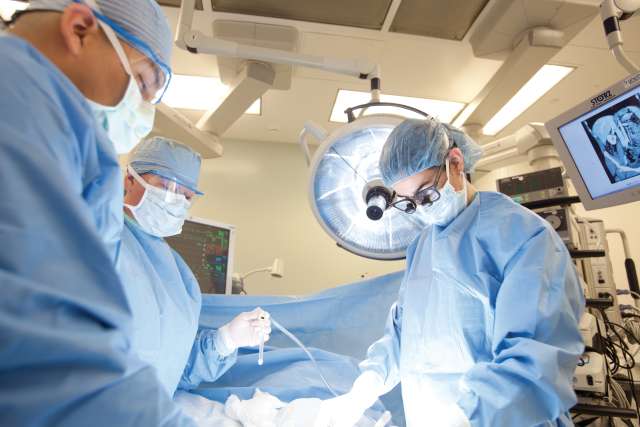Gene therapy — a leading-edge new way to combat sickle cell disease — is one of the treatments available through UCLA Health’s program. For many patients, the therapy is life-altering. Chandra Wallace hopes she will be one of them.
Wallace, 34, a UCLA Health patient, has had symptoms for as long as she can remember. The blood disorder, which is widely prevalent among African Americans, affects her hemoglobin, the major protein in red blood cells that carries oxygen in her body. Her hemoglobin is rigid and sickle-shaped, rather than round and flexible. This causes red blood cells to get stuck and block blood flow. The result is intense pain in the legs, abdomen and back. The disease can also cause problems like infection and stroke.
Right now, she says, she feels fragile for a week out of every month, and if she overexerts herself, she could easily slip into a sudden episode of severe pain known as a sickle cell crisis. She has to take two medicines — crizanlizumab and L-glutamine — to help manage her symptoms, and was hospitalized in April 2024 due to pain she couldn’t control at home.
She is grateful that it was the first hospitalization in more than one year, but she is eager for gene therapy, which aims to help her avoid crises in the future by enabling her red blood cells to carry oxygen freely in the body.
“From my understanding, gene therapy will make my hemoglobin normal, which means I can do a lot of more normal things,” says Wallace.
Wallace is going through testing to make sure she’s a good candidate for the treatment. She is also waiting for insurance approval to move forward.
Gary Schiller, MD, a hematologist at UCLA Health who treats Wallace, says the program offers one form of gene therapy and will soon have another. The therapies either correct the inherited error in the gene, or they make the body create the kind of hemoglobin produced by a fetus in the womb, which doesn’t have the sickle-shaped distortion.
“Gene therapy is a big deal,” he says. “It involves chemotherapy. It also involves mobilizing stem cells to leave the bone marrow and go into the blood where they can be collected and sent off to a company that can genetically modify them. Patients have to be observed for a minimum of 15 years after gene therapy because we are manipulating the blueprint of bone marrow stem cells.”
“I’m excited to get gene therapy so I don’t have to suffer once a month anymore or deal with side effects such as ulcers or acute chest syndrome — that’s the hope,” Wallace says, noting that she’s prepared to deal with possible side effects of chemotherapy, such as infertility and hair loss.
A multidisciplinary team approach
UCLA Health provides much more than gene therapy, however. The team includes another hematologist in addition to Dr. Schiller, as well as half a dozen primary care doctors, a social worker and Erica Martinez, NP, MSN, DNP, a nurse practitioner.
When asked whether it has made a big difference in her life to have the support of UCLA Health in managing her sickle cell disease, Wallace answers simply: “100%.”
“I can message Erica or my team, or call the clinic any time I’m suffering,” she says. “I constantly need prescriptions, and I can just message them. They know how to navigate this.”
Wallace, like many sickle cell disease patients, has found that some emergency room (ER) doctors don’t understand her condition and think she is just trying to get drugs when she has a pain crisis.
Martinez notes that the program’s outpatient program improves patients’ quality of life, and the infusion center enables them to avoid the ER.
Staying strong
As difficult as this condition can be, Wallace wants people to know that sickle cell disease doesn’t define her.
“Just because I have this illness does not mean that I have a horrible life,” she says. “I have a thriving career. I’ve accomplished a lot. I wish employers and people in general would have grace for someone who’s dealing with something chronic. If I’m having a monthly crisis and it happens during the week, that doesn’t mean I’m not going to get my work done. It just means that I need more time.”
More than anything, Wallace is grateful for her life and is looking forward to the future.
“I was born with this illness, so I’ve been dealing with it my whole life,” she says. “Hopefully everything goes to plan and I live a long, healthy life.”





